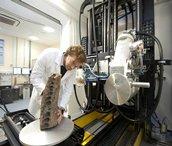Seminar 15th June 2011 3:30 p.m. University of Southampton, Building 7 (Lanchester) Room 3031
"In-Vivo Imaging of Plant Roots" and "MEMS Development for Advanced Applications-Substitute for Polysilicon as MEMS Structural Material" and "Materials Data Centre"
Keyes/Zhong/Scott
University of Southampton, Engineering Sciences
- Web page
- http://www.southampton.ac.uk/ses/research/groups/engmats.page?
- Categories
- MEMS
- Submitter
- Petrina Butler
All are invited to attend the next
Engineering Materials Internal Seminar Series (EMISS)
Time: 15:30:00-16:45, Wednesday 15th June 2011
Location: RM 3031, Bldg. 7 (Lanchester)
There will be three presentations given respectively by Sam, Le and Mark:
(1) ‘In-Vivo Imaging of Plant Roots’
By Sam Keyes
Abstract
Phosphate is a vital nutrient in sustaining agriculture, but reserves are likely to run out within the next century. At present the mechanics of phosphate uptake by plants are not well understood, since the soil in which their roots reside is a complex, opaque medium. It is known that better understanding of plant root activity is constrained by the limitations of present study methods. Micro-scale CT offers the possibility of characterising both roots and the soil environment in three dimensions. The aim of the present work is to develop protocols for plant and soil imaging, as well as linking plant growth and soil parameters to existing models of phosphate diffusion.
(2) ‘MEMS Development for Advanced Applications-Substitute for Polysilicon as MEMS Structural Material’
By Le (Randy) Zhong
Abstract
Due to the high annealing temperature, MEMS structure based on poly-Si is incompatible with modern CMOS microelectronics technique. In current MEMS devices, the mechanical structures and the control electronics are fabricated separately and then connected by wire bonding and wafer bonding, which increases complexity, cost, and noise. A co-sputtered Si/Ti film presents a possible structural material for post CMOS MEMS fabrication and therefore MEMS and CMOS monolithic integration. In previous studies, such material has shown mechanical and electrical properties similar to that of poly-Si, the current material of choice in MEMS structures. This project starts from the deposition and characterization of co-sputtered Si/Ti film with 10% Ti wt., a composition of optimized properties found in previous study. The current focus of this project is to develop a feasible fabrication route of typical MEMS structures (bridges and cantilevers) using this material. These structures not only demonstrate the functionality of the material, but also offer the bases for further mechanical testing, such as nano-indentation.
(3) ‘Materials Data Centre’
By Mark Scott
Abstract
Materials data can be expensive or time consuming to produce, creating a dilemma: whether to share it with others and lose a competitive advantage or keep it private, limiting the contributions that others could bring. Even before a publication can be made, the data is still important to researchers and it may be desirable to share datasets among colleagues within a research team. This is not always easy; USB hard drives are commonly used to the store the data with central storage servers proving expensive to build and maintain. Small projects with small budgets and few staff but large datasets seem common. The Materials Data Centre aims to provide a safe place to store and backup materials data which can then be shared with others in your research group and ultimately the wider materials community. We will show some of the types of data that might be stored and demonstrate the MDC prototype we have built over the past year.
Tea, coffee and biscuits will be served from 15:15.
Contact
Dr Nong Gao
Materials Research Group, School of Engineering Sciences
University of Southampton
Southampton SO17 1BJ, United Kingdom
Tel. (00-44) (0)23-80595094
FAX (00-44) (0)23-80593016
E-mail: N.Gao@southampton.ac.uk
